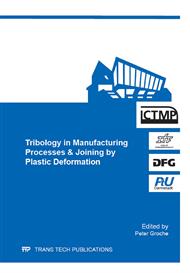p.270
p.281
p.290
p.301
p.311
p.323
p.336
p.347
p.357
On the Importance of Thermo-Mechanical Modelling of the Double Cup Extrusion Test
Abstract:
Finding the correct friction coefficient for the simulation of bulk metal forming processes is crucial. The practical approach nowadays for this objective is to conduct a friction sensitive process-test and the corresponding numerical simulation in order to reveal the friction coefficient. The Double Cup Extrusion Test (DCET) is one of the widely used friction tests for bulk metal forming. Although, there is a large body of literature on DCETs, there are still important aspects which have not been addressed yet. Motivated by this fact, this study emphasizes and demonstrates the importance of thermo-mechanical modelling to evaluate the DCET for the characterization of friction coefficients even for cold forging processes. To this end, thermo-mechanical material characterization covering necessary temperature and strain rate spectrum is conducted and used in the thermo-mechanically coupled finite element analysis (FEA) of the DCET. These findings are compared with the results of single flow curve based purely mechanical FEA in terms of cup height ratios as well as force-displacement curves for two different press speeds.
Info:
Periodical:
Pages:
311-322
Citation:
Online since:
June 2014
Authors:
Price:
Сopyright:
© 2014 Trans Tech Publications Ltd. All Rights Reserved
Share:
Citation:


